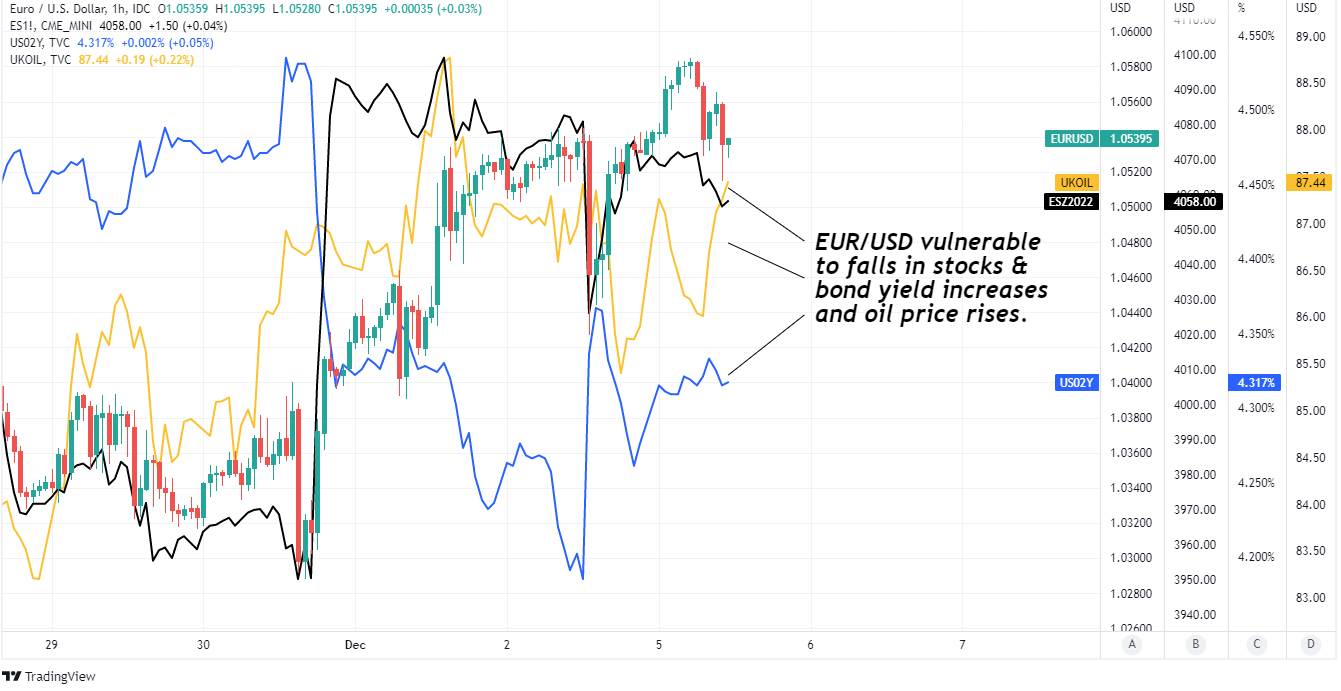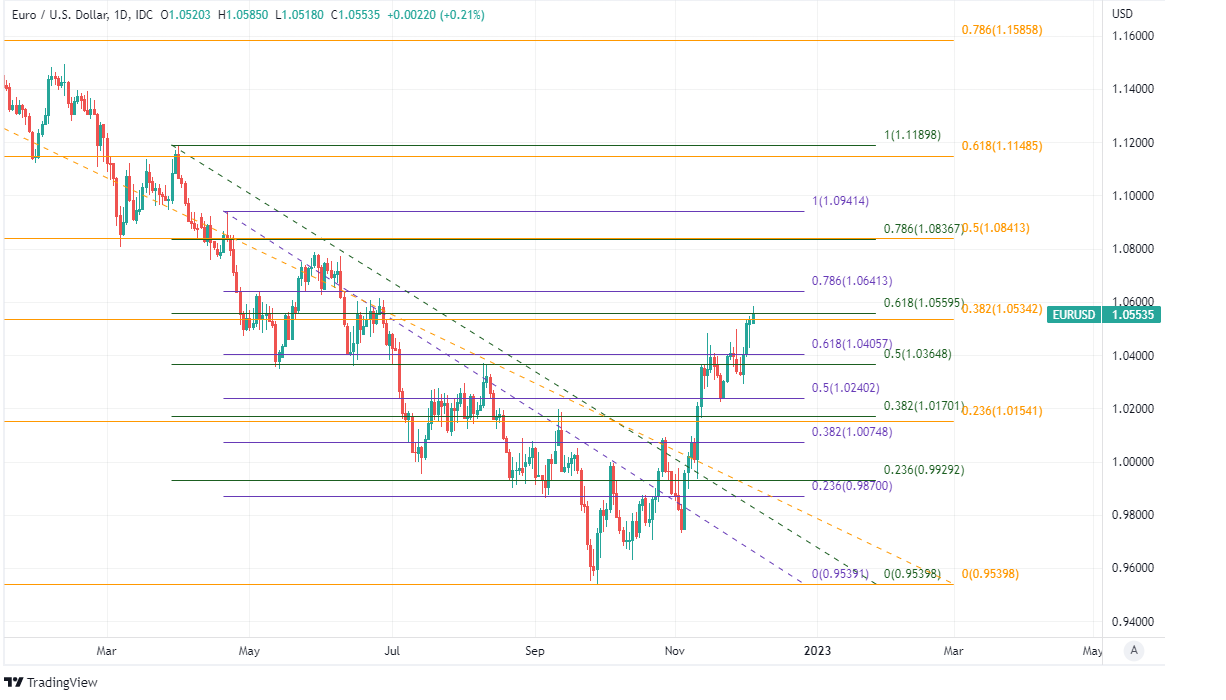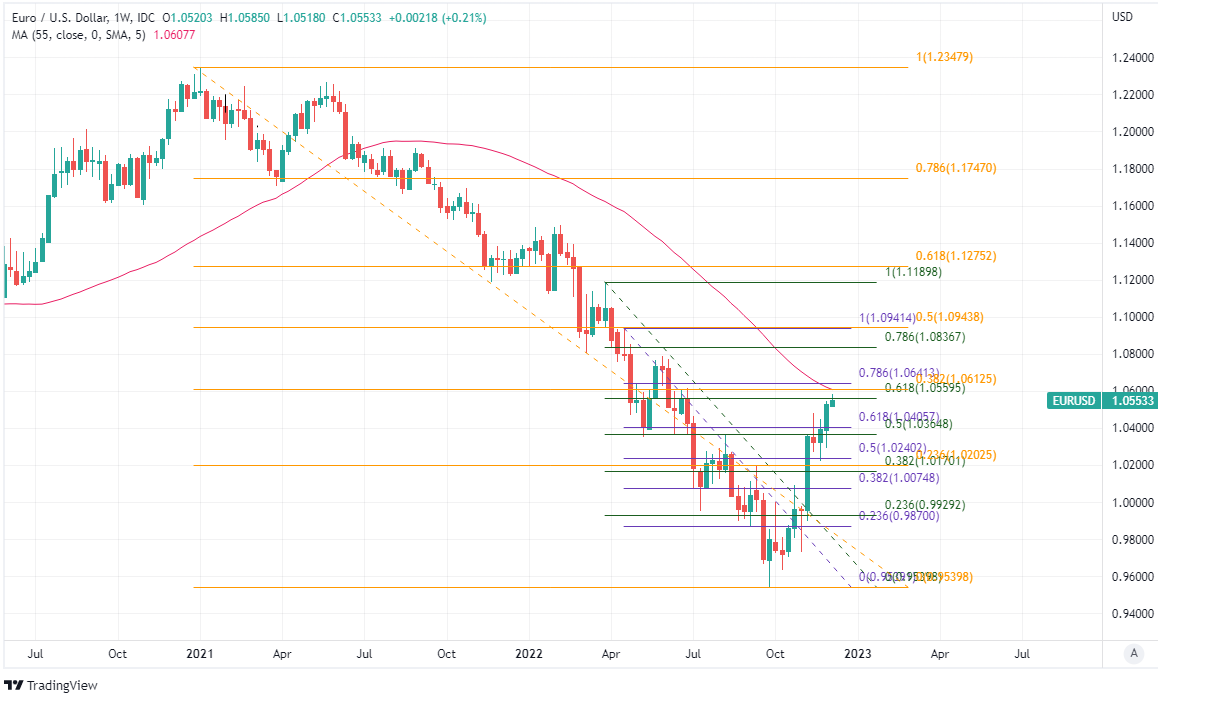EUR/USD Week Ahead Forecast: Recovery Runs Short of Road
- Written by: James Skinner
- EUR/USD facing multiple resistances above 1.06
- Could stall recovery without pick up in momentum
- But energy prices, U.S. data pose downside risks
- China reopening supports Europe & risk appetite

Image © European Union - European Parliament, Reproduced Under CC Licensing.
The Euro to Dollar exchange rate entered the new week on the front foot with help from a rallying Renminbi but will risk being frustrated in its recovery once into a nearby thicket of technical resistances on the charts without a further significant setback for the Dollar, which might be unlikely over the coming days.
Europe's single currency had faltered on Friday when the Dollar and U.S. bond yields benefited from November's non-farm payrolls report suggesting that employment demand and wages have continued to run at rates likely to keep the Federal Reserve (Fed) fretting about the U.S. inflation outlook.
But the Dollar's Friday rebound was only fleeting and unable to prevent the single currency attempting to build further on last week's gains on Monday when it appeared to be buoyed throughout the Asia Pacific trading session by another rally in Renminbi exchange rates.
"Optimism that lifting Covid restrictions in China will boost growth cannot be overlooked for the price action this morning as higher equities and commodities keep the dollar on the backfoot after a very brief but futile effort to claw background on Friday," says Kenneth Broux, a strategist at Societe Generale.
"The whopping gain in average earnings of 0.6% m/m (5.1% yoy) inevitably raised suspense for CPI next week and more fundamentally begs the question how fast inflation can realistically slow with a cooling of the labour market," Broux writes in a Monday market commentary.
 Above: EUR/USD shown at hourly intervals with U.S. 02-year government bond yield, oil price and S&P 500 index future.
Above: EUR/USD shown at hourly intervals with U.S. 02-year government bond yield, oil price and S&P 500 index future.
Easing of coronavirus containment measures in China are a boon for the Renminbi and currencies of economies exporting to China, such as the Euro, although many analysts have flagged that energy prices will also be back on the radar again this week along with U.S. economic data risks.
"Energy-related news should be more relevant for the euro this week, with falling temperatures in Europe and the price cap on Russian oil coming into effect today," says Francesco Pesole, an FX strategist at ING Group.
"Given the high sensitivity of EUR/USD to the eurozone’s terms of trade (which is primarily driven by energy prices), further upside risks for energy commodities equal downside risks for the euro," Pesole says on Monday.
Pesole and colleauges cite Monday's implementation of a 'price cap' on Russian oil exported to other countries and the prospect of a Russian retaliation that lifts market prices as a possible risk to the Euro-Dollar rate this week, which they've warned could be likely to slip back to 1.0450 or below.
"This week, some dollar stabilisation could make the EUR/USD rally run out of steam around the 1.0600/1.0650 area, and possibly lead to a more sustainable drop below 1.0450/1.0500. We remain bearish into year-end," Pesole says.
Above: Euro to Dollar rate shown at daily intervals with selected moving-average and Fibonacci retracements of January 2021, March 2022 and April 2022 downtrends indicating possible areas of technical resistance for Euro. Click image for closer inspection.If you are looking to protect or boost your international payment budget you could consider securing today's rate for use in the future, or set an order for your ideal rate when it is achieved, more information can be found here
Rising energy prices can weigh on the Euro currencies of other energy importing economies because they have an adverse impact on the terms-of-trade ration of export prices to import prices and can lead to more currency being sold on the market to pay for imports.
However, the Euro will be influenced by more than just energy prices this week as U.S. economic data including the November edition of the Institute for Supply Management (ISM) Services PMI out on Monday and Thursday's release of the latest producer price and inflation expectations data will also matter too.
"As demonstrated by the reaction to the November payrolls report, it is possible that investors have been choosing to view recent markets events and data in an overly optimistic manner," says Jane Foley, head of FX strategy at Rabobank.
"The continued tightness of the labour market should focus attention on the persistence of core inflation and the duration of the Fed’s policy response. It is our view that the Fed will need to hold rates at the terminal rate until 2024," Foley writes in a Monday market commentary.
Monday's ISM PMI will provide insight into the condition of the largest economic sector in the U.S. last month and it's possible, if not somewhat likely that any better-than-expected outcome would lead U.S. bond yields and the Dollar to attempt a recovery to the detriment of the Euro.
Above: Euro to Dollar rate shown at weekly intervals with selected moving-average and Fibonacci retracements of January 2021, March 2022 and April 2022 downtrends indicating possible areas of technical resistance for Euro. Click image for closer inspection. To optimise the timing of international payments you could consider setting a free FX rate alert here..
Dollar exchange rates have fallen heavily in the weeks since October's inflation data was released in early November suggesting that U.S. price pressures may be moderating to the benefit of the single currency while the Euro-Dollar recovery extended further last week.
Euro-Dollar gains were most notable after Fed Chairman Jerome Powell reiterated that U.S. interest rates are unlikely to rise as fast as they have done going forward but also warned of lingering upside risks to the likely peak for borrowing costs.
He singled out wage growth in the labour market and the services sector as a significant risk to the bank's effort to return inflation to the 2% target and reiterated his own earlier view that U.S. data has most recently argued in favour of lifting interest rates higher than was suggested back in September.
"EUR/USD's path of least resistance this week is higher in our view. Markets are pricing FOMC rate cuts by mid-2023. In comparison, markets expect the European Central Bank (ECB) to continue increasing interest rates throughout 2023," says Joseph Capurso, head of international economics at Commonwealth Bank of Australia.
"The divergent outlooks for the two central banks suggest interest rate differentials will continue to be influential on EUR/USD. On the data front, Eurozone October retail sales are likely to remain subdued given the numerous headwinds facing consumption," Capurso writes in a Monday note to clients.






